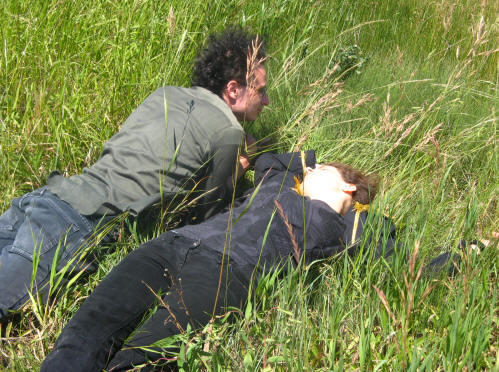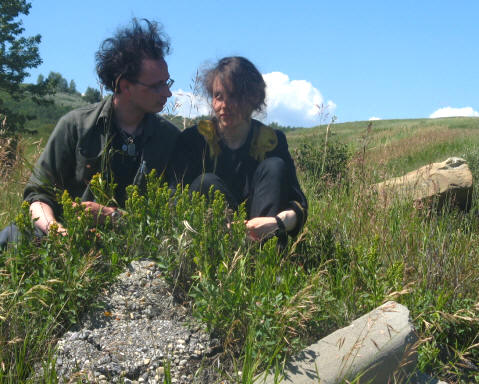|
INFORMATION
ALBUMS
MUSIC
VIDEO
LIVE PICTURES
LINKS
|

Some Different Tales...
Death
Ray Gun. Blaise Kolodychuk and Elaine Boyling got together in 2000,
they built a gigantic metal machine to ride around in and spread the
word of the kittenpeople to the humans of Earth, they called this
machine Dr. Hoojib. Dr. Hoojib finally stopped rolling for a while
and Blaise and Elaine got out, they found themselves in the belly of
a giant squid, it was here that they settled to make a record, they
called it fukachuk pandora machine. They soon got back into the
giant metal Dr. Hoojib and left behind fukachuk pandora forever. Dr.
Hoojib kept rolling along, for years in fact, and many moons were
spent feeding on the flesh of the dead. They received a radio
transmission from the King of Mars, he told them that the people
there were revolting and that is was because there were no more
blaise and elaine songs left on the planet for them to chant along
to.. it was a horrible mess up there on Mars I tell you. So it was
to be fate. Blaise and Elaine stopped Dr. Hoojib again... but all
was different now, the moon above them was glowing green and the
chickens in the farms were all singing a different song. Blaise and
Elaine decided to build the Immense 'Death Ray Gun' so as they could
use it to beam the sounds they make back home, to Mars... they got
to work right away, and in the year of our lord 2003, it was
completed. There were 28 separate pieces to the puzzle and all were
transmitted one by one to the Martian people, they all explained the
mission, and what has gone terribly wrong with the planet earth, the
same planet they themselves were sent to so many years ago as
missionary of a truth that can not even be spoke of any more...


Pretend
Science - Death Ray Gun
Sometimes the failed or unnoticed ideas and intentions of the
present can be as important and pervasive in the future as the
actions or ideas which won out to become reality in their own time.
If things are recorded or remembered, and sustained somehow, they
can have a gradual effect in instigating actions, or on individual
and societal imagination, or they can be found later having been
hidden and have huge sudden explosive and implosive impacts. The
importance of failing, of finding wrong answers, is often
underestimated, but it is essential to any new process of
exploration or curiosity. For instance, in the development happening
at the moment in Wet Robotics - the synthesis of muscles and basic
cell-like machines, there is as much to learn about life by being
right as by being wrong.
For societies preoccupied with measuring IQ, the Flynn Effect - the
continuous rise of average IQ test scores over time - seems to
suggest that children today are more intelligent or at least better
educated than their parents and grandparents. The interesting thing
is that IQ tests only measure certain kinds of intelligence. It
means that we have become better at teaching children to pass
certain kinds of tests by giving certain kinds of answers. Professor
Jim Flynn, the man that noticed the rising IQ scores, remains
convinced that it isn't a sign people are getting brainier so much
as a sign that the way we think is changing. He describes how when
answering a question from the Wechsler intelligence tests for
children, What do dogs and rabbits have in common? , a child
from the 1900s would most likely give a utilitarian answer,
you use dogs to hunt rabbits, and a child today would give a
classification answer, they're both mammals. As
Professor Flynn put it the scientific spectacles now sit on
our noses fairly comfortably. We think of the world as something to
classify rather than something to manipulate. (Professor Jim
Flynn Newsnight BBC2 2007)
For general daily life, questioning the nature of reality is
something which can get in the way and make people uncomfortable.
People have come to believe more and more in the certainty of facts
provided by science, and that curiosity and finding things out for
yourself, or simply wondering about them, are the job of elite
scientists. People either aren't interested, or they feel like they
don't have enough understanding to start with to bother thinking
about it. At the same time, everything must be explained as a matter
of scientific fact, to put people's minds at rest. David Malone
says, "science has become, in the minds of many, the new guarantor
that there is certainty and that we can attain it." This misses the
point that, as any big thinker points out, the more you know, the
more you realise how little you know, how much more there is to
learn.
Why do people think that uncertainty and incompleteness are
failings? All scientific theories could be said to be partial
approximations of the truth, if there is truth. It cuts into a very
old human impulse for finding beauty and perfection in something
complete and certain. This is the same mode of thought where modern
art or music gets considered shocking or ugly and worthless. It is
the same reason brilliant thinkers like Einstein were so vehemently
opposed to the work of Niels Bohr and Heisenberg's uncertainty
principle. If scientific understanding can't be certain and
complete, how can it be beautiful or satisfying?
But that is reductionist, and can be blinding; only finding value in
things that are Real or True. Uncertainty isn't dead though, at the
extremes of thought today, "for the modern counterparts of Godel and
Turing - the likes of Roger Penrose and Gregory Chaitin -
intellectual certainty is a dead end. Serious thinkers are not
afraid of uncertainty. For them a theory's uncertainty or
incompleteness is not a failing but a positive and creative
condition in its own right. The profound discoveries of modern
mathematics and science show that life and thinking flourish only in
the liminal and fertile land that lies between too much certainty
and too much doubt. The art of scientific inquiry is to tack back
and forth between the two." (David Malone, Dangerous Knowledge BBC4
2007, from http://cabinet-of-wonders.blogspot.com/)
The Death Ray was a theoretical weapon imagined by Nikola Tesla.
Between the 1920s and 1930s several people came up with ideas for
death rays, independently of each other, and Tesla wasn't the first
or last. On the internet people put Tesla apart from the other
ideas, although usually laughing at how wacked-out his idea was, for
the genuine engineering competence behind his designs.
Tesla hated war, and was driven to invent something which could make
war obsolete, or at least reduce it to a mere spectacle of
machines. He suggested that the borders of a country could be
ringed by towers containing death ray generators, which would send
out teleforce particle beams to destroy any enemy
approaching from the land, sea or air by harnessing electrical
energy in a way that, he said, "no one has ever dreamed about."
The Death Ray Gun had a huge, more or less unshakeable influence on
weapons in science fiction. Even though most scientists today
consider Tesla's idea as flawed, it influenced the charged-particle
beam weapon developed by both the United States and the Soviet Union
during the cold war, and new weapons still being developed such as
the non-lethal but still pretty scary Active Denial System microwave
beam weapon already used in service in Iraq by the U.S. military,
and intended for use on protestors and demonstrators. In a funny way
it is its prominence in science fiction that makes the Death Ray Gun
seem a plausible, even necessary, solution to problems in reality.
That the weapon, and the problems, are all only one imagined version
of reality apparently slips by unnoticed to most of the people
involved in the action. To be fair, its hard to think when you're in
the beam of an ADS and your body thinks its on fire.
Anyway, don't blame Tesla, he wanted his peace-ray to
stop war, not create tyranny, and he was excited about exploring
unexplored technology. This was a time on the verge of the atomic
age, when electricity still had some romantic intrigue for the
general public, when the imagined future was still an optimistic
metropolis of skyscrapers and expressways and trails of flying cars,
before people were disillusioned by the reality of congestion and
rush-hour misery.
But are people too disillusioned? Why are so many ideas for the
future, or even the present, reduced to predicting environmental
doom or something like that? People seem to take an attitude that is
either nihilism or or absolutism, What happened to the place
in between, where we explore? . Do schools, and all the other ways
people learn how to think, encourage empiricism and curiosity, and
the possible value of tolerating ambiguity enough? Just because a
way of thinking of things makes sense, that does not make it
reality. And in the same way being wrong does not make an idea
insignificant or useless, or even necessarily inferior to the
‘right' answer.
This whole thing sounds pessimistic now which is unfair, because
there are all kinds of things happening in the world, the small ways
people find to effect the world and make it better, which really
matter. For one thing the internet, and other new technology, seems
to be giving people forums for the beginnings of wild innovations
and explorations. Some people might be saying that modern culture is
dumbing down, that the factual unreliability of wikipedia, or the
amount of terrible, boring, self-obsessed nonsense there is on
youtube or myspace or facebook, people might say that is all awful,
but wow.. its really amazing... there could be room for anything at
all, anything you imagine, and you can just do it on your own or
with your friends, and put out somewhere to be recorded and
remembered, and maybe have an impact on the present or the future,
or at least make an imprint. And its a weird funny anarchic mess of
mutual aid, in terms of making ideas exist. And these kinds of ideas
of innovation, and making ideas real, maybe people can be inspired
by the amount of impact they can have on the internet, and have that
level of imaginative effect on their physical environments too,
things like this: (just for example)
http://cabinet-of-wonders.blogspot.com/2007/07/genius-loci-spirits-of-place.html
http://cabinet-of-wonders.blogspot.com/2007/07/babylon-pavement-paradises.html
http://www.realitysandwich.com/glamour_s_and_parallel_worlds
As two people making music mostly over the internet, Death Ray Gun
can't give up the uncertainty principle, and can't turn off
curiosity and amazement at the world, or exploration, hunger, fear,
disbelief, total belief, and suspension of belief in the known and
the unknown, and the fantastical and the unknowable, and everything
in between. Especially the inbetween.
most of this is mangled from
http://cabinet-of-wonders.blogspot.com

Death
Ray Gun is:
Elaine
Boyling & Blaise Kolodychuk
with Terry Ramsay for live shows. |

